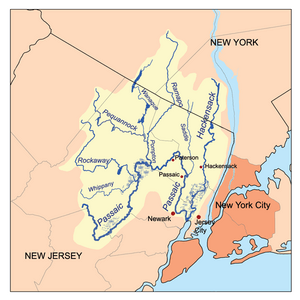Saddle River (Passaic River tributary) facts for kids
- For the municipalities named for the river, see Saddle River, New Jersey and Upper Saddle River, New Jersey.
The Saddle River is a cool waterway that flows south through a big part of Bergen County, New Jersey. It passes through many towns where lots of people live. The river got its name from another river way over in Saddell in Scotland.
Contents
Where the Saddle River Starts
The Saddle River begins in the hills of Rockland County, in southern New York state. Small streams from this area flow south. They all meet up about two miles south of the New York state border. This meeting point, where the Saddle River officially begins, is in the town of Upper Saddle River, New Jersey.
Journey Through Towns
From its start in Upper Saddle River and its feeder streams near Airmont, New York, the Saddle River travels about 16.3 miles south. It flows through many different towns. These towns include Saddle River, Waldwick, Ho-Ho-Kus, Ridgewood, Glen Rock, Paramus, Fair Lawn, Rochelle Park, Saddle Brook, Lodi, Garfield, and Wallington.
Meeting Other Waters
One important stream that joins the Saddle River is the Ho-Ho-Kus Brook. This brook flows into the Saddle River in an area called Dunkerhook, which is part of Saddle River County Park. When these two waterways meet, it marks a spot where four Bergen County towns come together: Ridgewood, Paramus, Glen Rock, and Fair Lawn.
The Saddle River's journey ends in the towns of Garfield and Wallington. Here, its water flows into the larger Passaic River. The Passaic River then empties into Newark Bay. From there, the water travels through the Arthur Kill and Kill van Kull before finally reaching the huge Atlantic Ocean. The northern part of the Saddle River's area is located between the Ramapo River to the west and the Hackensack River to the east.
Amazing River Animals
The Saddle River is home to many different kinds of fish! You might find largemouth bass, pickerel, bullhead catfish, and various types of sunfish. There are also different kinds of trout in the river. Most of these trout are put into the river by the New Jersey Division of Fish and Wildlife. However, in the very top parts of the river and some of its smaller streams, you can find wild brown trout living naturally.
Protecting Wild Trout
These wild trout face a challenge. When people use too much lawn fertilizer in nearby homes, it can wash into the river. This extra fertilizer can cause too much algae and weeds to grow in the water, which can be harmful to the wild trout. It's important to be careful with what goes into our waterways to keep them healthy for all the animals.
Tributaries


